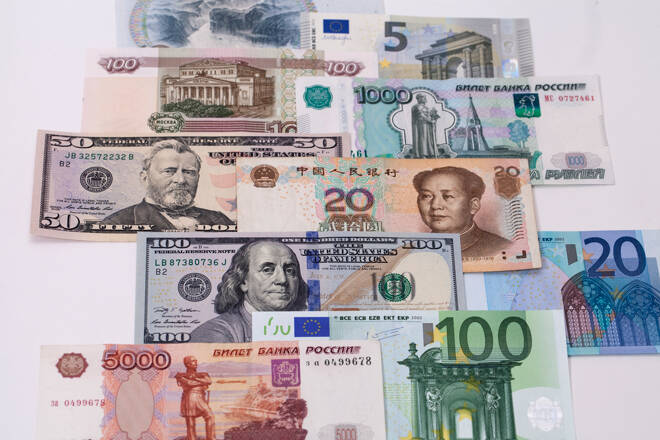Advertisement
Advertisement
The Weekly Wrap – Upbeat Omicron News Delivered another Dollar Loss
By:
It was another bearish week for the Greenback, with a pickup in market risk appetite weighing. The Pound and the Loonie were front runners in the week.
The Stats
It was a particularly quiet week on the economic calendar, in the week ending 31st December.
A total of 15 stats were monitored, which was down from 33 stats in the week prior.
Of the 15 stats, 9 came in ahead forecasts, with 5 economic indicators coming up short of forecasts. There was just 1 stat that was in line with forecasts in the week.
Looking at the numbers, 10 of the stats reflected an upward trend from previous figures. Of the remaining 5 stats, 3 reflected a deterioration from previous.
For the Greenback, it was a 2nd consecutive week in the red. In the week ending 31st December, the Dollar Spot Index declined by 0.36% to 95.670. In the previous week, the Dollar had fallen by 0.57% to 96.019.
Out of the U.S
Jobless claims was the key stat in the week, with the markets looking to assess the impact of the Omicron strain on labor market conditions.
In the week ending 24th December, initial jobless claims fell from 206k to 198k. Economists had forecast an increase to 208k.
PMI numbers also drew interest. In December, Chicago’s PMI rose from 61.8 to 63.1, which was also market positive.
Other stats in the week included goods trade data, inventory, and housing sector figures. The stats had a muted impact on the markets, however.
Out of the UK
There were no major stats to provide the Pound with direction. Market bets of a more hawkish outlook on Bank of England monetary policy delivered support, however.
In the week, the Pound rose by 1.09% to end the week at $1.3532 In the week prior, the Pound had risen by 1.06% to $1.3386.
The FTSE100 ended the week up by 0.17% following a 1.41% gain from the previous week.
Out of the Eurozone
Unemployment figures from France and inflation figures from Spain were the key stats in the week.
In November, jobseeker totals declined from 3,142.5k to 3,087.8k.
More significantly, however, was a marked pickup in inflationary pressure in Spain.
According to prelim figures, Spain’s annual rate of inflation accelerated from 5.5% to 6.7%. Economists had forecast a more modest pickup to 5.7%.
For the week, the EUR rose by 0.45% to $1.1370. In the week prior, the EUR had risen by 0.70% to $1.1319.
The EuroStoxx600 rose by 1.10%, with the CAC40 and the DAX30 ending the week up by 0.94% and by 0.82% respectively.
For the Loonie
It was a particularly quiet week, with no key stats from Canada to provide direction. The lack of stats left market risk sentiment to influence in the week.
In the week ending 31st December, the Loonie rose by 1.39% to C$1.2637 against the Greenback. In the week prior, the Loonie had gained 0.57% to C$1.2815.
Elsewhere
It was a bullish week for the Aussie Dollar and the Kiwi Dollar.
The Aussie Dollar rose by 0.58% to $0.7263, with the Kiwi Dollar gaining 0.12% to end the week at $0.6826.
For the Aussie Dollar
There were no major stats to provide direction ahead of the coming week’s RBA monetary policy decision.
Better than expected private sector PMIs from China and a pickup in risk appetite delivered support, however.
For the Kiwi Dollar
It was also a quiet week for the Kiwi Dollar, with no major stats for the markets to consider.
For the Japanese Yen
Retail sales and industrial production figures for November impressed in the week.
Retail sales rose by 1.9%, year-on-year, versus a forecasted 1.9%. In October, retail sales had increased by 0.90%.
Industrial production jumped by 7.2% month-on-month, following a 1.8% increase in October. Economists had forecast a 4.8% increase.
The numbers had a muted impact on the Yen, however. A pickup in risk appetite stemming from Omicron news updates weighed on the Yen.
The Japanese Yen declined by 0.61% to ¥115.080 against the U.S Dollar. In the week prior, the Yen had fallen by 0.58% to ¥114.380.
Out of China
It was a relatively quiet week on the economic data front. NBS Private Sector PMIs were in focus at the end of the week.
In December, the NBS Manufacturing PMI rose from 50.1 to 50.3, with the Non-Manufacturing PMI increasing from 52.3 to 52.7. Economists had forecast a fall in the Manufacturing PMI to 50.0.
In the week ending 31st December, the Chinese Yuan rose by 0.18% to CNY6.3561. In the week prior, the Yuan had ended the week up by 0.12% to CNY6.3677.
The Hang Seng Index ended the week down by 0.35%, while the CSI300 rose by 0.39%.
About the Author
Bob Masonauthor
With over 28 years of experience in the financial industry, Bob has worked with various global rating agencies and multinational banks. Currently he is covering currencies, commodities, alternative asset classes and global equities, focusing mostly on European and Asian markets.
Advertisement
